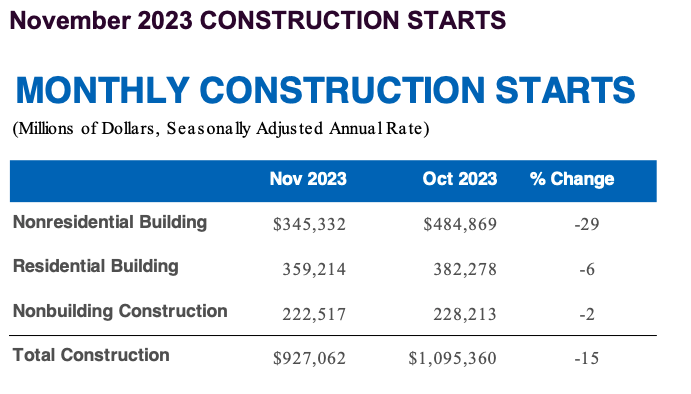Total construction starts fell 15% in November, dropping to a seasonally adjusted annual rate of $927 billion, according to Dodge Construction Network. Nonresidential building starts fell 29% during the month, residential starts lost 6%, and nonbuilding starts dropped 2%.
Highway and bridge starts were down 8%.
Year-to-date through November 2023, total construction starts lagged by 4% compared to the previous year. Residential and nonresidential starts were down 14% and 7%, respectively, but nonbuilding starts were up 19%.
“Construction starts are deeply feeling the impact of higher rates,” said Richard Branch, chief economist for Dodge Construction Network. “While the Federal Reserve seems poised to start cutting rates in the New Year, the impact on starts will lag. As a result, starts are expected to be weak through the mid-point of 2024 before growth resumes.”
Nonbuilding
Nonbuilding construction starts in November fell 2%, amounting to a seasonally adjusted $223 billion. As stated, highway and bridge starts decreased 8%, environmental public works starts fell 4%, utility/gas starts rose 17%, and miscellaneous nonbuilding starts improved by 1%.
Year-to-date through November, nonbuilding starts were up 19% overall. Utility/gas plants rose 49%, and miscellaneous nonbuilding starts increased 18%. Highway and bridge starts gained 9%, and environmental public works rose 11%.
The largest nonbuilding projects to break ground in November were the $834 million I-405 Brickyard to SR 527 improvements in Bothell, Wash., the $406 million second phase of the Sherco Solar Farm in Becker, N.M., and a $353 million addition to the Silverhawk Generating Station in Moapa, Nev.

Nonresidential
Nonresidential building starts decreased 29% in November to a seasonally adjusted annual rate of $345 billion. Manufacturing starts plummeted 74% following a strong several strong project starts in October. Commercial starts fell 19% with office buildings being the only category to see a gain. Institutional starts rose 7% due to a significant uptick in healthcare activity. Year-to-date through November, total nonresidential starts were 7% lower than in 2022. Institutional starts gained 5%, while commercial and manufacturing starts fell 13% and 18%, respectively.
The largest nonresidential building projects to break ground in November were the $1.9 billion Children’s Hospital of Philadelphia Inpatient Tower in Pa., the $1.6 billion LG Energy Battery Plant in Queen Creek, Ariz., and the $750 million expansion of the Iowa Army Ammunition Plant in Middletown, Iowa.
Residential
Residential building starts declined 6% in November to a seasonally adjusted annual rate of $359 billion. Single-family starts increased 1%, while multifamily starts fell 19%. Year-to-date through November 2023, total residential starts were down by 14%, with single-family starts dropping 15% and multifamily starts by 12%.
The largest multifamily structures to break ground in November were the $200 million 55 Broad Street residential conversion in New York City, the $200 million redevelopment of The Superman Building in Providence, R.I., and the $185 million Union West mixed-use development in Raleigh, N.C.
Regionally, total construction starts in November fell in the Midwest, South Atlantic, South Central and West regions, but rose in the Northeast.
Single-Family Homes
Single-family home construction surged in November as lower mortgage rates helped to assuage affordability concerns and unleash pent-up demand for housing.
Overall housing starts increased 14.8% in November to a seasonally adjusted annual rate of 1.56 million units, according to a report from the U.S. Department of Housing and Urban Development and the U.S. Census Bureau.
Sales of newly built, single-family homes in November fell 12.2% to a 590,000 seasonally adjusted annual rate, according to newly released data by the U.S. Department of Housing and Urban Development and the U.S. Census Bureau. The pace of new home sales in November was the lowest annual rate since November 2022 but sales are up 3.9% on a year-to-date basis due to a lack of resale inventory.

